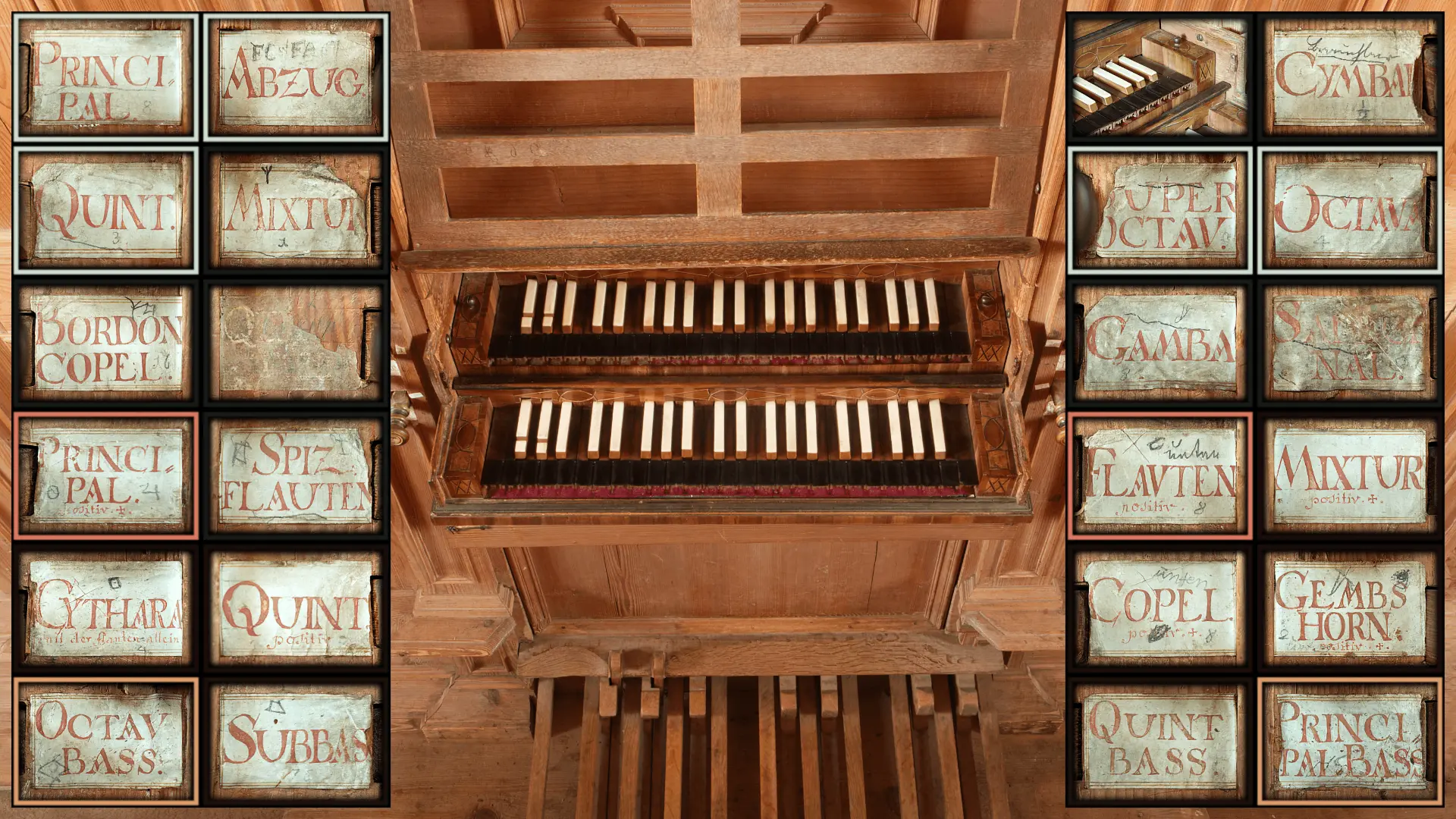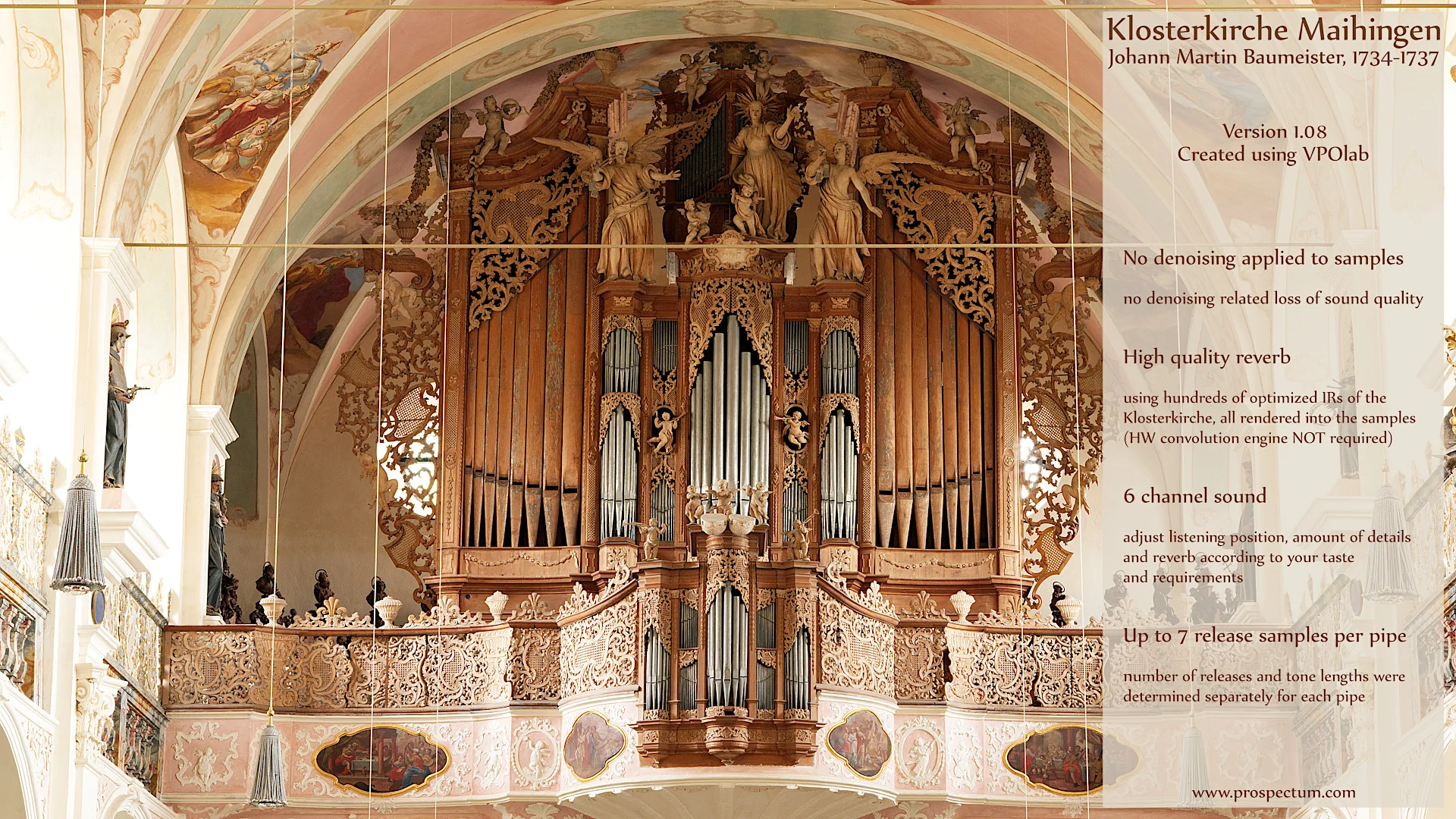The installation files can be downloaded from the PROSPECTUM website.
The installation manual and the free iLok trial key are available in my webshop.
The Baumeister Organ
According to Dr. Josef Hopfenzitz (Die Baumeister-Orgel von 1737 in der Klosterkirche Maihingen, 1991, ISBN 3-927496-12-X), Johann Martin Baumeister constructed this unique organ between 1734 and 1737, except for the Rückpositiv, which is attributed to Jakob Philipp Bouthellier. What makes it so remarkable is that, due to a series of fortunate circumstances, it is remarkably well-preserved, including its original voicing. During the secularization of the monastery of Maihingen, the instrument was sealed in October 1802 and ceased to be used for masses, which were then held in the nearby parish church, Mariä Himmelfahrt. Moreover, Baumeister didn’t provide an entrance to the organ, which likely hindered any attempts to perform maintenance work for a considerable period. Consequently, when the organ was finally opened and restored from 1988 to 1990, it was essentially in its original state, as built and voiced by Baumeister.
The restoration was meticulously carried out and exceptionally well documented. The objective was to make the organ playable while minimizing any alterations to preserve its original state. Since it remained in its original state, its sound is unusual for modern ears. As Christoph Bossert illustrates, it requires patience and involvement to fully appreciate its unique qualities. Notably, the organ boasts incredibly beautiful 8′ flute, string, and Quintatön stops, including the Cythara 8′ flute stop, which is a celeste stop that can be used with the Flauten 8′ stop to create a tremulant effect.
Stop List
I. Rückpositiv
Copel 8′
Cythara mit der Flauten allein 8′
Flauten 8′
Principal 4′
Quint 3′
Gembshorn 2′
Mixtur III 1′
II. Hauptwerk
Bordon Copel 16′
Principal 8′
Spitzflauten 8′
Quintatön 8′
Gamba 8′
Salecinal 8′
Octava 4′
Quint 3′
Superoctav 2′
Mixtur IV 1′
Cymbel III 1/2′
P. Pedal
Principalbass 16′
Subbass 16′
Octavbass 8′
Quintbass 6′
Compass
Manual compass: C – c³ (short octave), extended to C – g³
Pedal compass: C – a0 (short octave), extended to C – f¹
Couplers
Abzug (HW-PD)
Schiebekoppel RP-HW
Koppel RP-PD (Hauptwerk extension)
Tuning
Modified meantone, f(a1) = 427.7 Hz
Sample Set
- 6 channels (3 stereo channels -direct, indirect, church) of chromatically sampled stop-by-stop pipes.
- No denoising applied - no denoising related loss of sound details.
- Up to 7 release samples per pipe: more natural sound, playing artifacts substantially reduced compared to conventional wet sets.
- Sample resolution: 24bit / 48kHz stereo.
- Action noises (keys, stops etc.) and blower noise (can be switched on/off) included.
- Carefully designed wind model of the Baumeister organ.
- Single / dual portrait / landscape screens to fit all consoles.
- Comes with two temperaments: the original Maihingen temperament obtained by analysis of the samples and the official temperament of the organ as published by Hopfenzitz in 1990.
RAM Requirements
6 channels, 24-bit lossless compression, multiple sample loops: 18.7 GB
6 channels, 20-bit lossless compression, multiple sample loops: 17.3 GB
6 channels, 16-bit lossless compression, multiple sample loops: 10.2 GB
Audio Samples (on Contrebombarde)
- Anton Estendorffer (1670-1711): Galliarda Octabi Toni and variations (07:24)
- RP demo (53-63-69): Muffat, Gottlieb (1690-1750): Toccata prima und Verseti in d-Moll (05:48)
- HW demo (53-63-69): Muffat, Gottlieb (1690-1750): Toccata Seconda und Verseti in g-Moll (05:43)
- Wolfgang Ebner (1612-1665): Pieces from 56 Versetten durch die acht Kirchentöne (20:03)
- Johann Speth (1664-1721): Toccata Prima – Erstes Musikalisches Blumenfeld (04:00)

